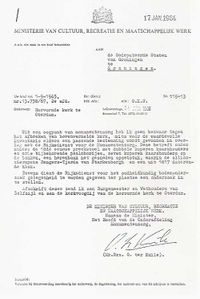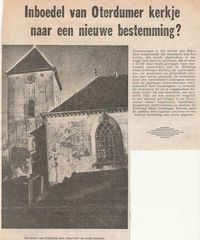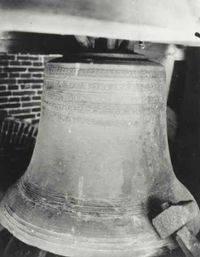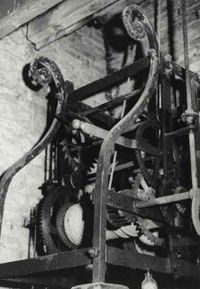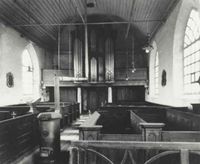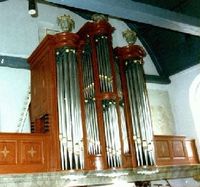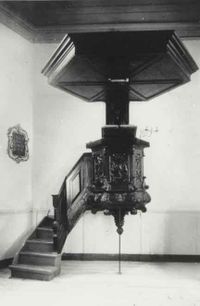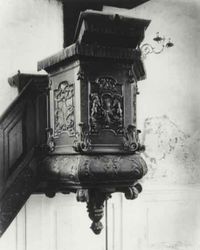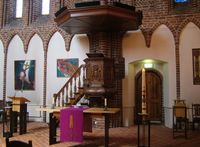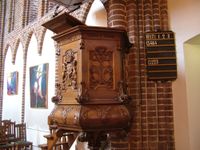Relocation of valuable parts
The Minister of CRM(culture) had, as appears from a letter dated 17 January 1966, few objections to its demolition, provided that a suitable destination could be found elsewhere for the valuable parts of the inventory.
The bell
The bell rang for the last time on 7 September 1969. It had been in service for over 350 years (1617 - 1969).
The bell was officially put into use in the church of Oldehove on 11 February 1983.
The following text is on the bell:
'Ao 1617 IS DEZE KLOCKE S.LAMBERTUS GEHETEN, CASPEL OTERDUM HEFT MY LATEN GETEN DEN8 MAY, DO JAIRUS HERMANNI, LAMBERT LUITTIENS, GYSE JACOBS PASTOR UN KERCKSWOREN WHAREN GEHETEN.... HANS NORTMEYER ME FACIT.'
The clockwork
The clock is placed in the church of Jukwerd.
The organ
The Lohman organ dates from 1855.
On Sunday 7 September 1969 the organ was played
for the last service in the church of Oterdum. The organ was moved to the NH Church
in Heinenoord and was put into use there on 22 January 1984.
The situation in Heinenoord
"Daor broest de zee..."
"There the sea is broiling..."
These words apply to the visit made in September 1966 by the organists of the time, one of whom is still in service, to the "Jutterskerkje" in Oterdum.
This church contained a Lohman organ dating from 1855. The instrument, like the church, was found in a neglected state. Oterdum was scheduled to fall victim to the expansion of Delfzijl. The pipes showed tin-pest marks and, like the action, did not function properly. Thanks to the cooperation of the presiding churchwarden Van Delden, it was still possible to play the organ. The wind supply was only achieved by intense footwork. The organ was played in turn by the two Heinenoord organists J. Jongekrijg and A.J. den Boer. When the churchwarden was completely out of breath, the Heinenoord brothers were so far that they dared to ask for an option on the instrument. Despite the externally poor condition of the Oterdum organ, the sound charmed these musicians so much that they could not get enough of the organ playing.
After a report on the state of affairs had been issued in Heinenoord, it was up to the board of churchwardens to decide. They took the fortunate decision to take further steps leading to the purchase. It soon became apparent that the purchase was not an easy matter. Various authorities were not prepared to approve the transaction without further ado. After all, it concerned a valuable organ with the status of a monument.
"Door wys beleid bestuurd..."
"Governed by wise policy..."
The church council and church wardens soon gave the green light, but before the purchase became a fact, a lot of correspondence had to be done. In February 1969, the provincial government of Groningen finally gave permission to sell the instrument to a municipality outside Groningen. In December 1969, the deal was sealed, and in that month the church wardens also received the first invoice from the company Flentrop in Zaandam for the storage of the organ in its workshop.
In mid-September 1973, the construction of the instrument began. The case, which had already been placed earlier, was then painted and made ready to contain the pipework and everything else that was needed. The organ builders Boogaards and Dekker of the company Flentrop had the task of correctly assembling the thousands of parts that make up the organ. This was done with great precision and craftsmanship and took two months. Then the tuner-intonator De Ruiter and his assistant Grisnich could start with the most time-consuming work: tuning and intonation. Thanks to the willing cooperation of these professionals, it was possible to use the "new organ" at Christmas 1973. A few registers had been prepared for this. However, it would take until 22 March 1974 before the organ was officially put into use at the same time as the restored church in a festive church service.
The pulpit
The pulpit from the church has been moved to the NH Church in Winschoten.
The pulpit dates from around 1745, with carvings by Casper Struiwig (1698 - 1748) after a design by Jan Bitter.
The situation in Winschoten
